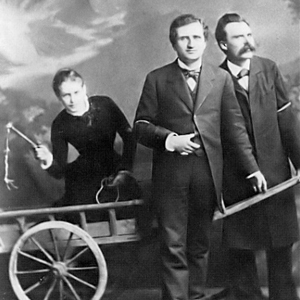
Your complimentary articles
You’ve read one of your four complimentary articles for this month.
You can read four articles free per month. To have complete access to the thousands of philosophy articles on this site, please
Irish Philosophy
Horseplay in Hibernia
Seán Moran explores equine escapades in Eire and elsewhere.
‘Hibernia’ is the Latin for Ireland. The Romans didn’t use the word much though, because (unlike our neighbour, Britannia) they never invaded Ireland. Perhaps they were scared of the dancing girls with their long curly wigs, kitsch Celtic dresses, and ferociously competitive mammies. In any case, they had a cheek naming our country Hibernia, which literally means ‘Land of Winter’. They seem to have mixed us up with Narnia. We actually have four seasons – admittedly sometimes on the same day.
When present-day Romans visit for a summer holiday, they soon discover that Ireland loves horses. This national characteristic runs across all socio-economic classes. When Queen Elizabeth came to Ireland, she made a pilgrimage to my home county of Tipperary, to admire the thoroughbred racehorses in the paddocks and stables of stud farms. Horses are also found in impoverished Dublin housing estates, and in Traveller encampments around the country. The young charioteers in my photograph are members of the Irish Traveller community. A similar image of a charioteer struggling to control recalcitrant horses appears in Plato’s dialogue Phaedrus – though in Ireland we call a chariot a ‘sulky’, and the minor drama depicted in my photo took place in a cloudy Tipperary town, not under the blazing sun of Athens.
In Plato’s allegory, the chariot of the soul (psyche) is pulled by two horses, one mortal, one immortal. Both horses have wings, but the mortal one is a “crooked lumbering animal… hardly yielding to whip and spur” (Phaedrus, 253). This steed represents our desires or appetites (epithumia). By contrast, the immortal horse is “upright and cleanly made… a lover of honour and modesty and temperance, and the follower of true glory; he needs no touch of the whip, but is guided by word and admonition only.” This second horse symbolizes our thumos – a term that has no direct equivalent in English, but is often translated as spiritedness, boldness, or ‘heart’. The task of the charioteer – who represents our human powers of reason (logos) – is to control these two horses, particularly the unruly epithumia, which would otherwise drag us towards satisfying our base, hedonistic instincts, and into catastrophe.

Photo © Seán Moran 2021
The charioteer, governed by reason, is the best part of our psyche; the crazy horse following its unruly desires is the worst; and the noble horse, doing what it considers to be honourable, is somewhere in-between. There are inevitable comparisons with Sigmund Freud’s superego, id and ego, but Plato got there over two thousand years before the Viennese voluptuary, and his analysis is arguably more nuanced than Freud’s. Even though the honourable horse is likelier to do the right thing than the wild horse, this is not guaranteed: it can still ‘lose the run of itself’ as we say in Ireland. Without the restraining influence of reason, thumos can take off spiritedly in totally the wrong direction, boldly convinced in its heart that it’s right. Homer in the eighth century BCE gives us a vivid example of thumos going astray, in his epic poem The Iliad. As the Trojan prince Hector lies dying at the hands of Achilles, he pleads with the victorious warrior to give him an honourable burial. Achilles roars back at him: “My thumos would drive me now to hack your flesh and eat it raw – such agonies you have caused me!” Then he ties Hector’s dead body behind his chariot by the feet, and drags it through the dust around the city of Troy, thereby dishonouring Hector in death. In his rage, Achilles has become an uncivilized brute. The noble horse of his psyche has gone rogue.
We are unlikely to experience such viciously dramatic events in our own lives – not commonly in rural Tipperary, at any rate – but it’s a vivid reminder that we can’t always trust our intuitions about the right thing to do. Many atrocities are boldly committed by people who firmly believe they’re pursuing an honourable, even glorious, course of action. Nor should we stop our appetite-driven horse from having the occasional hedonistic treat, or it will only sulk (especially if it’s pulling a sulky). But it’s usually a good sign when our mind and heart agree about the best thing to do. This Platonic combination of rationality and spirit – logos and thumos – is needed to make fine things happen, because the soul is motivated to go in the right direction.
Horses For Courses
So much for Plato’s use of horses in his philosophy: what about his student Aristotle? That thinker certainly discussed horses seriously in his writings; but I can’t resist instead sharing with you a scurrilous equine story about Aristotle that’s been doing the rounds among philosophers for centuries.
Aristotle was acting as tutor to Alexander the not-yet-Great when he discovered that his pupil had fallen in love with a young woman called Phyllis. Aristotle was worried that this love affair would distract Alexander from his royal duties and his philosophical studies, so he counselled him to cool his passions. Phyllis heard about this and decided to humiliate Aristotle. She seduced him by prancing bare-legged through the morning dew, with her hair billowing in the breeze – like a slow-motion, soft-focus shampoo advert. Aristotle looked out of his glassless study window and was smitten by this vision of loveliness. He implored Phyllis to be his. She agreed, with one proviso: he had to put on a saddle and bridle and become her horse for a ride round the garden. Later that morning, Alexander looked down from the battlements, amazed to see his respectable old tutor with a bit between his teeth and a saddle on his back, being whipped by young Phyllis as he cantered through the grass.
Enough of this. Although it was widely told – and luridly depicted in the sixteenth century by artists including Lucas van Leyden and Johann Sadeler – the story of Phyllis and Aristotle probably isn’t genuine. So let’s move on to my completely true philosophical anecdote about a horse in Ireland.

Nietzsche and friends
I was recently taking some photographs at the castle of eighteenth century Irish philosopher Bishop Berkeley, in nearby county Kilkenny – it’s not a long way to Tipperary – when a horse that had been grazing behind me decided it wanted to be in the picture. She ambled past me to pose elegantly in front of the castle. Berkeley famously claimed that things only exist while they’re being observed (esse est percipi), so I looked away… and the horse disappeared. It reappeared when I looked at it again, and it was in the photographs when I developed the film. I would show you the image, but the negative also seems to have disappeared from my darkroom while no-one was watching.
As compensation for failing to produce my picture of a horse at Berkeley’s castle, I offer you instead a photograph of nineteenth century German philosopher Friedrich Nietzsche playing a horse.
Nietzsche knew about the rumours of Aristotle acting as a horse for Phyllis in Alexander’s garden, and he decided to re-enact the scurrilous scene for the camera. In it he and his friend Paul Rée are being whipped by Phyllis, played by Lou Salomé, as he pulls her cart like a moustachioed Teutonic dray-horse.
Unfortunately, this jokey horsey tableau vivant foreshadowed poor Nietzsche’s demise. Seven years later, on January 3rd 1889, in Turin, Italy, he was horrified to see a horse being beaten by its owner in the Piazza Carlo Alberta. Overcome with pity for the animal, Nietzsche threw his arms around the mare’s neck, weeping manically, before falling to the ground. He never recovered his mental health after this episode, and spent the last eleven years of his life under psychiatric ‘care’.
On a lighter note, I’ve just been re-reading a book by the Irish satirist Jonathan Swift. Gulliver’s Travels (1726) can be read as a fantasy travelogue, like Homer’s Odyssey (except that Odysseus endures many perils so that he can return home to his wife and son, whereas Gulliver can’t wait to escape his family and homeland to embark on his next adventure). Alternatively, the stories can be interpreted as satires on the social and political mores of Swift’s time. But the book is also deeply philosophical, and this is where horses come into the picture yet again. Indeed, the intelligent horses, the Houyhnhnms, whom Gulliver encounters on an island south of New Holland (now called Australia), are the philosophical heroes of his narrative: “As these noble Houyhnhnms are endowed by nature with a general disposition to all virtues… their grand maxim is to cultivate reason, and to be wholly governed by it.”
The horses are ideal citizens of a state much like Plato’s Republic. In fact, Gulliver’s host, a highly intelligent steed, “agreed entirely with the sentiments of Socrates, as Plato delivers them.” In keeping with Plato’s ‘model’ society, which is marred by eugenics and repressive social control, the Houyhnhnms practise a type of slavery, in which there is a “race of inferior Houyhnhnms bred up to be servants.” However, even these servile horses are superior to the primitive humanoid Yahoos, who represent fallen, depraved humanity. In barbs directed at two apparently respectable human professions, Gulliver is pleased that “here was neither physician to destroy my body, nor lawyer to ruin my fortune.” (A little unfair to doctors, perhaps.) And as a Protestant clergyman, Swift couldn’t resist mocking the Catholic doctrine of transubstantiation, the idea that the bread turns into the real body of Christ during the mass: Gulliver says that in Europe, lives were lost debating “whether… bread be flesh” – something the intelligent horses in the story would never believe. Naughty Reverend Swift.
What do you think? Has considering horses made a worthwhile contribution to philosophy over the centuries? Yea, or neigh?
© Dr Seán Moran 2021
Seán Moran, RIP, taught postgraduate students in Ireland, and was professor of philosophy at one of the oldest universities in the Punjab.






